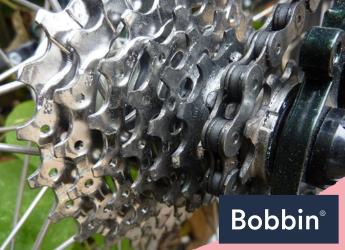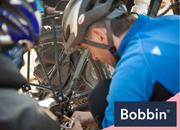What Is a Bike Sprocket?
Various components, from the small knickknacks to larger parts, make up a whole bike. One such vital part is the sprocket — a gear that enables your pedals to turn and propel you forward. This guide covers all the basics, so read on to learn more about it.
What Is a Bike Sprocket?

At its core, a bike sprocket is a tooth-like mechanical wheel with a small notch. It’s positioned on the cranks and the rear wheel, designed to rotate and engage with the chain or belt.
The front sprocket or chainring initiates the power transfer from your pedalling motion. In contrast, the cassette fine-tunes this power delivery for different terrains.
Bike sprockets are often made from steel, a hardwearing material that offers longevity. Some models are aluminium-made, which is lighter and ideal for push bikes, e.g., balance bikes.
The anatomy of a sprocket

- Number of teeth: This is the total number of teeth. Each ‘tooth’ contributes to the power transmission.
- Pitch diameter: Found at the inner point where the chain engages.
- Outside diameter: The measurement around the edges of the sprocket’s teeth. It impacts the rotational dynamics and overall size of the gear assembly.
- Pitch: Represented in inches, the pitch denotes the measurement per tooth. It ensures compatibility with the chain’s pin spacing.
Sprockets come in varied tooth counts, determining their load-bearing capacity. More teeth mean a sprocket can handle heavier loads, but there's a trade-off. More teeth also mean increased friction, resulting in a reduction in operating speed. It's a delicate balance between strength and speed.
As the chain traverses the sprockets over time, it gradually wears down the notches. If the notches get sharp or hooked instead of staying blunt, it means it’s time to replace them.
How do bike sprockets work?
The chain or belt connects to two main gears: the ‘driver’ and the ‘driven’. When both start moving, they transfer power or adjust speed and force in a mechanical system. It’s a simple but effective partnership that drives the machinery.
Different Sprocket Sizes and Gear Ratios
The size of your bike sprockets determines how easy or fast you can pedal. It can also affect your riding performance overall. Bigger gears in the front and small ones in the back make for faster pedalling on flat roads. Meanwhile, small gears in the front and big ones in the back make it easier to pedal uphill.
Tip: Try different combinations to see which is best for different riding situations.
Types of Bike Sprockets
Explore the diverse world of sprockets, each designed for specific functions:
- Double duty: As the name suggests, it features two teeth per pitch. Once the set is worn down, the links can be advanced to a new set of teeth.
- Hunting tooth: This type of sprocket has an uneven number of teeth. It outlasts others by engaging new teeth with each turn, reducing wear on each tooth.
- Segmental rim: Ideal for industrial settings, these sprockets have replaceable bolt-on rims. They minimise downtime during installation or adjustment.
- Multiple strands: Geared for high torque and power needs. This sprocket type excels when driving two or more items with a common shaft.
- Quick disconnect (QD): Suited for heavier workloads. QD offers a reverse mounting function for versatility.
- Idler: Applied where chains may slack or encounter obstacles. The idler prevents whipping and ensures even load distribution. Suitable for long chain lengths.
How to Maintain Sprockets?

Here are some upkeep tips:
- Regularly clean the bike sprockets with a brush and mild degreaser to remove dirt and grime.
- Inspect the teeth for signs of wear, chipping, or bent teeth and replace them if necessary.
- Lubricate with a high-quality chain lube. As with bike chain maintenance, this will help reduce friction and prevent rust.
- Check the chain tension regularly; adjust if needed to ensure proper alignment.
- Keep the entire drivetrain, including the chain, clean to keep the sprocket debris-free.
- Avoid riding in extreme conditions, such as mud or sand, to prevent chain wear.
- Replace the entire set of sprockets and chains as a set to maintain performance.
Round-up
Bike sprockets make sure that each pedal counts. Understanding how they work, their parts, sizes, and types lets you adjust your ride as needed. And while you’re here, why not also take a look at our selection of bike replacement parts?
Should you have any questions, feel free to contact us. Next on your reading list: On the Chain: How Do Bike Gears Work?








